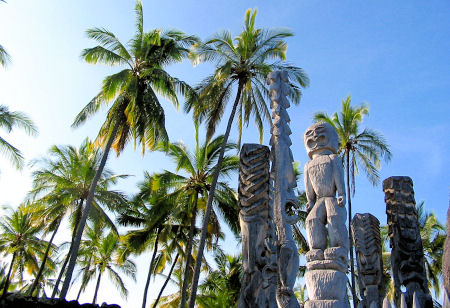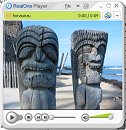|
|
Pu'uhonua o Honaunau
National Historic Park

|

Honaunau Video
|
One of the most accessible, interesting, and enchanting cultural
sites in the State of Hawaii is the Pu'uhonua o Honaunau National
Historical Park.� Translated, the "Place of Refuge at Honaunau"
is the most complete restoration of an ancient Hawaiian religious
sanctuary in Hawaii.
For a preview of Honaunau Place of
Refuge, view the video on the left.
 Take
a Virtual Tour of
Honaunau Take
a Virtual Tour of
Honaunau
�
|
On the black lava flats of the
southern Kona Coast, Pu'uhonau o Honaunau is a preserved ancient
Hawaiian village.� This National Park is located adjacent to
the excellent snorkeling spot of Honaunau Bay.
 Tall
royal palms surround the temple complex that sits on a 20-acre
finger of lava bordered by the sea on three sides. The only access
to the pu'uhonua (temple of refuge) was by swimming across a bay
known as the shark's den. If you managed to survive, the kahuna
(priest) was required, under pain of death, to offer you sanctuary
and absolve you of all wrong doing.� Here in the national park
you can walk through an ancient Hawaiian village and see firsthand
how the kings of Hawaii once lived. Tall
royal palms surround the temple complex that sits on a 20-acre
finger of lava bordered by the sea on three sides. The only access
to the pu'uhonua (temple of refuge) was by swimming across a bay
known as the shark's den. If you managed to survive, the kahuna
(priest) was required, under pain of death, to offer you sanctuary
and absolve you of all wrong doing.� Here in the national park
you can walk through an ancient Hawaiian village and see firsthand
how the kings of Hawaii once lived.
 Puuhonua
O Honaunau National Historical Park (daily 7.30am-5.30pm; $2; ),
four miles on from Kealakekua, is the single most evocative
historical site in all the Hawaiian islands, jutting into the
Pacific on a small peninsula of Puuhonua
O Honaunau National Historical Park (daily 7.30am-5.30pm; $2; ),
four miles on from Kealakekua, is the single most evocative
historical site in all the Hawaiian islands, jutting into the
Pacific on a small peninsula of
 jagged
black lava. The grounds include a palace, with fishpond and private
canoe landing, and three heiaus , guarded by large carved effigies
of gods - reproductions, but still eerie in their original setting.
An ancient " place of refuge " lies firmly protected behind the
mortarless masonry of the sixteenth-century Great Wall.� Those
who broke ancient Hawaii's intricate system of kapu (taboo) -
perhaps by treading on the shadow of a chief, or fishing in the
wrong season - could expect summary execution unless they fled to
the sanctuary of a place such as this. As chiefs lived on the
surrounding land, transgressors had to swim through the
shark-infested seas. If successful, they would be absolved and
released overnight. jagged
black lava. The grounds include a palace, with fishpond and private
canoe landing, and three heiaus , guarded by large carved effigies
of gods - reproductions, but still eerie in their original setting.
An ancient " place of refuge " lies firmly protected behind the
mortarless masonry of the sixteenth-century Great Wall.� Those
who broke ancient Hawaii's intricate system of kapu (taboo) -
perhaps by treading on the shadow of a chief, or fishing in the
wrong season - could expect summary execution unless they fled to
the sanctuary of a place such as this. As chiefs lived on the
surrounding land, transgressors had to swim through the
shark-infested seas. If successful, they would be absolved and
released overnight.
More
photos and underwater videos
of Honaunau, Place of Refuge.
Hiking the 1871 Trail
 For
those wanting to explore further, the backcountry trail offers a 2 mile
round trip hike along the 1871 trail through the agricultural areas that
surround the park. On this trail, you will encounter Hawaiian heiau,
holua sled courses and the dramatic Keanae'e cliffs. For
those wanting to explore further, the backcountry trail offers a 2 mile
round trip hike along the 1871 trail through the agricultural areas that
surround the park. On this trail, you will encounter Hawaiian heiau,
holua sled courses and the dramatic Keanae'e cliffs.
The 1871 Trail follows the path of an ancient trail. It is part of a
system of trails that encircled the island to serve as trade routes.
This portion of the trail was last improved in 1871, hence the name 1871
Trail. The trail is part of Pu'uhonua o Honaunau National Historical
Park, and it begins behind the park's visitor center. Walking the trail,
you will be led through Hawaiian history and natural resources until you
reach the abandoned village of Ki'ilae.� More information on the
1871 Trail -
NPS website.� Ask at the visitor center for a backcountry trail
guide.� For information call:
(808)328-2326
Attractions: ancient
Hawaiian ruins, national park
Activities: picnicking, swimming, fishing, snorkeling,
diving, kayaking, sunbathing
Extras: parking lot and bathrooms at national park
Directions
- Take Rte 11 South
from Kailua Kona for about 19 miles.� Take a right on Hwy 160
(Ke Ala o Keawe Rd) near the 104 mile marker.� Be sure to
arrive early because parking is limited.� View
map of Honaunau.
Note - You can
also reach Honaunau via Kealakekua bay by traveling south on Hwy 160
for 3.2 miles.� Place of Refuge National Park ($5 entry)
immediately adjacent to beach park; bathrooms in the park
 Visit
The Sea
Caves Near Honaunau Visit
The Sea
Caves Near Honaunau
 Looking
for a unique island kayaking adventure?� Try kayaking
to the Sea Caves near Honaunau.� You can launch your
kayak right from the boat ramp at Honaunau and visit these
spectacular caves only accessible by water.� You can
even jump in the water and snorkel in the caves!� Kayak
the spectacular blue waters and visit the sea caves.�
Check out our detailed instructions and maps on how to
Kayak to the Sea Caves at Honaunau. Looking
for a unique island kayaking adventure?� Try kayaking
to the Sea Caves near Honaunau.� You can launch your
kayak right from the boat ramp at Honaunau and visit these
spectacular caves only accessible by water.� You can
even jump in the water and snorkel in the caves!� Kayak
the spectacular blue waters and visit the sea caves.�
Check out our detailed instructions and maps on how to
Kayak to the Sea Caves at Honaunau.
|
� |












